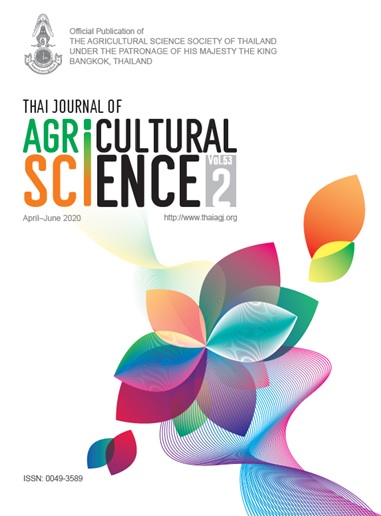Rubber wood properties testing for biomass energy by using visible–near infrared spectroscopy
Main Article Content
Abstract
When the rubber tree (Hevea brasiliensis) is 20–25 years old, the latex yield is not economically worthwhile. The rubber tree will be cut down. The rubber wood cut down is processed into dried rubber wood and will be used in downstream industries. The remaining are roots of trees and wood or branches that are not utilized, including rubber waste from wood processing plants and wood production plants, including wood slabs, sawdust, wood (flawed) and shavings. These parts of rubber trees can be used as biomass fuel. The study of timber that provides quality wood for biomass fuel is therefore necessary. Traditional rubber wood quality analysis (conventional method) is complicated, takes time and high cost. Therefore, this research aimed to develop a quality analysis of the biomass rubber with visible–near infrared (Vis-NIR) technique in order to create new alternative testing. In this study, Vis-NIR spectroscopy was employed to determine hemicellulose, cellulose, nitrogen (N), carbon (C), hydrogen (H) and moisture contents in rubber wood as biomass for energy utilization. The 120 rubber samples from 10 varieties were selected from three parts of trunk, limb and root with each aged twenty years. All samples were ground and measured using the reflectance mode in the Vis-NIR region of 680–2,500 nm. Partial least squares regression (PLSR) models for the quantitative determination of hemicellulose, cellulose, N, C, H and moisture contents in rubber wood samples were built. PLSR models were developed from the region of Vis-NIR spectra and the analyzed contents were determined by the reference method. The calibration models yielded acceptable statistical results for quantitative analysis of N with the coefficients of determination (R2) of 0.847, moisture with R2 of 0.839, hemicellulose with R2 of 0.835, H with R2 of 0.747, C with R2 of 0.664 and cellulose with R2 of 0.596. The results showed that the entire wavelength region of 680–2,500 nm provides more reliable PLS models (N, C, cellulose, and moisture) than those of models using a shorter wavelength region of 680–1,246 nm (hemicellulose and H). For rapid biomass testing, the PLS models created by the suitable data obtained from a flexible wavelength range selection of Vis-NIR spectrometer illustrated high feasibility for screening rubber wood properties.


